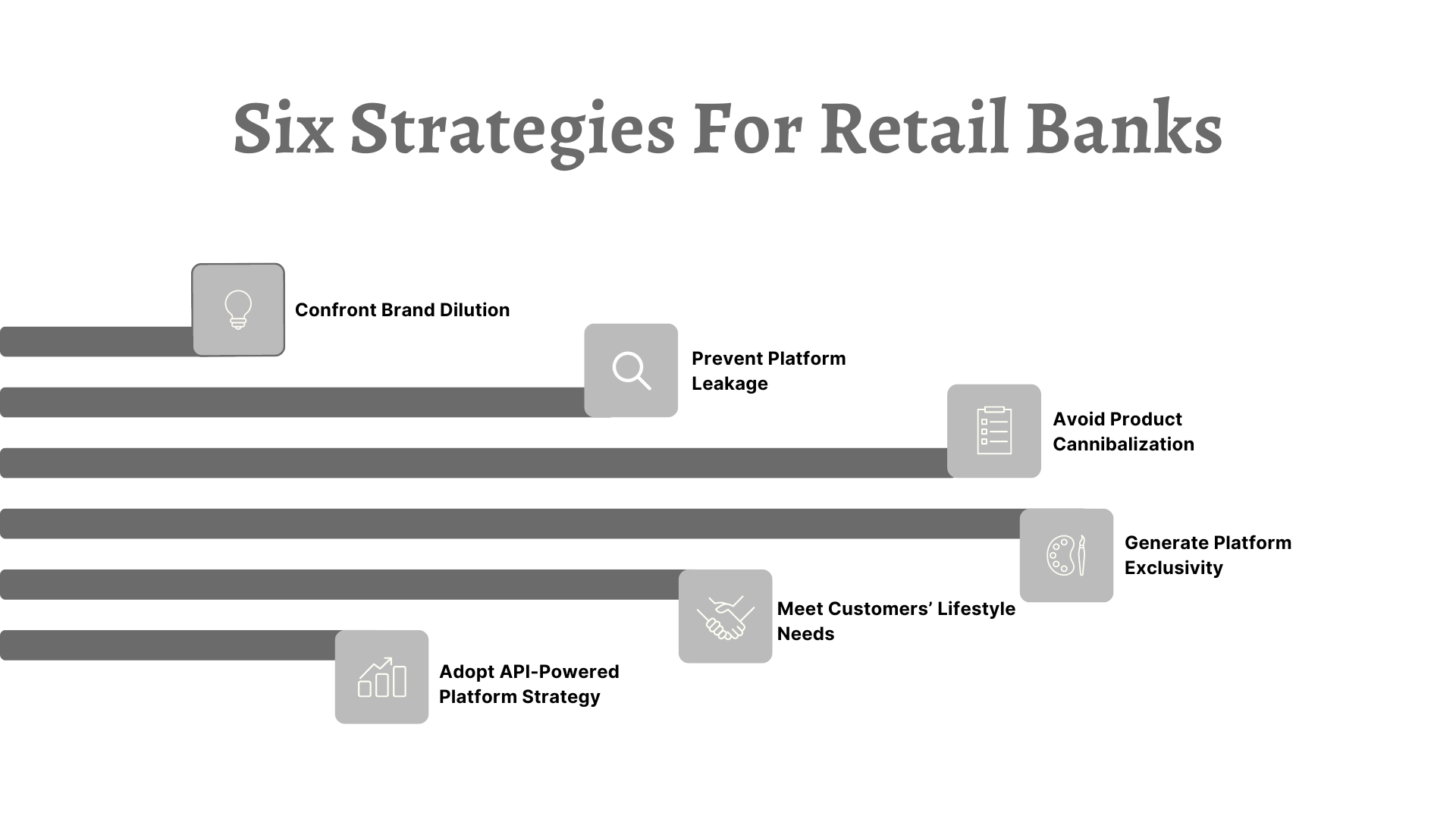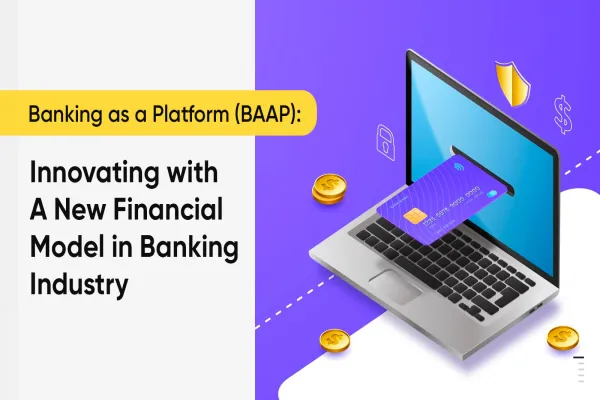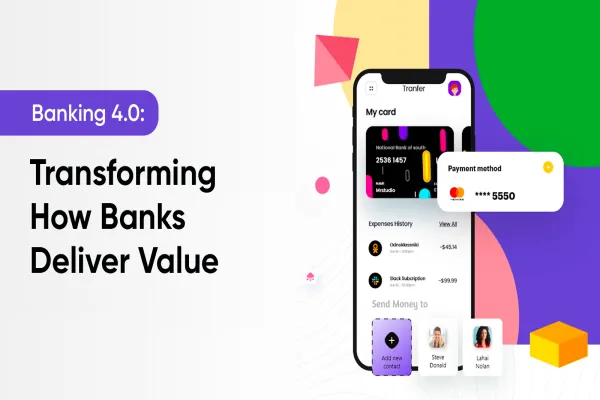In the first part of this two-series insights, we looked at why retail banks must ride the Banking as a Platform or BaaP wave to create revenue streams, enhance customer satisfaction, and build partnerships with fintech companies to walk toward new-age automation in finance.
McKinsey reasonably points out that “Banks are better served to get ahead of and define the trend rather than waging a futile battle to repel it.” Given that many CMOs, CIOs, and C-Suite Executives are interested to upend the status quo and explore possibilities that move past their set patterns of vertically integrated, closed-loop offerings, this blog will offer insights into a strategic roadmap for retail banks to compete in a platform world (Fig. 1)

Adopt API-Powered Platform Strategy
After a retail bank has demonstrated its maturity at the level of emerging or the intentional emergence stage on delivering a product set that involves APIs, it can go on to a more specific level for leveraging and monetizing APIs.
In order to adopt an API-fuelled platform strategy, banks must be ready to face organizational and technical challenges. At the organizational level, banks must bring a change in functional mindset through multidisciplinary team creation, redesigning customer expectation strategies, and reshaping business architecture. At the technology level, banks must pursue process automation, experimentation with rapid prototyping, updating development approaches, and maintaining APIs at the internal level.
Generate Platform Exclusivity
More than 50% of the banking executives in the World Retail Banking Report said that the critical challenges to maintaining brand exclusivity are- the multi-home nature of platforms, and the ability of partners to participate in multiple ecosystems. The survey also suggests that nearly three-quarters of the executives are worried about brand dilution in such an ecosystem.
Therefore to understand how banks can build and maintain exclusivity, they are also looking toward those industries which are taking the platform path. For instance, Amazon boosts homing costs by charging third-party sellers higher fees for orders not placed on the retailer’s marketplace. One way in which Banking as a Platform or BAAP can gain exclusivity is if they lock Fintech company or software development company in the strategic investment ecosystem.
Confront Brand Dilution
CMOs and CIOs, they can create strategies that are separate from core bank offerings. This way, they can ensure that their exclusive offerings get top billing and that the brand does not get diluted. An example in India is the digital application platform of HDFC Bank which provides loans against securities- mutual funds. It meshes an exclusive offering of loans into its exclusive digital application platform.
Avoid Product Cannibalization
Cannibalization is a chief concern of several bank executives, the survey in the World Retail Banking Report explains. Competition with fintech companies is a direct result of the digitization of financial services. But, one strategic way to avoid cannibalization could be to ensure that the partner products do not sit in direct competition with the bank’s product offerings. This will prevent the fintech companies from eating into the bank’s core business. Another method could be to avoid cannibalization, bank CMOs must work to ensure that they don’t invite third-party vendors with direct competition into their own ecosystem.
Meet Customers’ Lifestyle Needs
When banks seek to differentiate their Banking as a Platform or BAAP and build intense customer journeys through platform banking, they can mesh traditional offerings with lifestyle products that are non-financial in nature. Targeting lifestyle solutions that can drive customer engagement without jeopardizing bank offerings to a lower position in the chain can be a way to hit equilibrium.
For example, CaixaBank, a Spanish multinational financial services company, offers non-financial services like educational content, shopping, games, music, and video through its lifestyle banking platform while complementing its core financial offerings. After one year of launching its lifestyle banking platform, the mobile-only digital bank got hold of 3.1 million customers.
In this context, Zac Maufe from Google Cloud says, “embedded finance will be critical within the futuristic banking equation, where financial institutions are available whenever customers require financial services.”
Prevent Platform Leakage
Banking platform ecosystem can increase its value for customers and partners through cobranding arrangements and preferred pricing to ensure that there is no erosion in the banking ecosystem. To avoid third-party partners circumventing their banking platform and engaging directly with the bank’s customer base, CMOs can also offer support services to third parties. So this means that what begins with the banking platform must also stay there.
One example of preventing platform leakage can come from another industry, for instance, India’s travel and accommodation agency, OYO. They prevent customer leakage from its ecosystem by supporting partner hotels with advertising, financing, and brand management.
Measuring the Success of a Banking Platform
Banking as a Platform is a wave that’s still rising, and to which incumbent banks are not yet accustomed. The platform world operates in a different mindset than what retail banks are used to. So what is the right way to measure the success of a banking platform? “The accurate measure of an ecosystem will be the net impact of a consumer on the parent and associated entities,” said Raghuram Iyengar and David Reibstein, professors of marketing at the University of Pennsylvania’s Wharton School.
Effective metrics include network effects, customer acquisition rate, the effectiveness of engagement in the market, and asking internal questions like how diverse the platform is in their offerings and partnerships.
“The ripple effect of a single customer journey will be throughout the ecosystem. It can help derive the value that a particular customer brings in and the value that the customer can get driving engagement and network effects,” add Raghuram Iyengar and David Reibstein.
Future of Banking as a Platform as We See It
The nature of Banking as a Platform or BAAP is to grow gradually through an ecosystem of complimentary offerings through services and solutions. Hence, cross-platform offerings or hybrid business models such as Amazon pay-Icici Bank partnerships make way for the business.
If you’re interested in embedded banking into the platform and are looking to partner with a digital experience company, learn how Valuebound can assist you in carving a successful BAAP journey.





